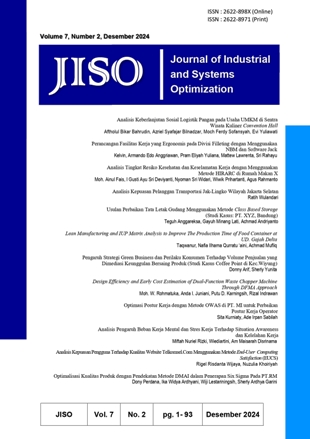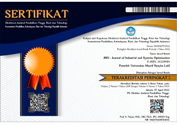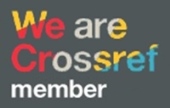OPTIMALISASI KUALITAS PRODUK DENGAN PENDEKATAN METODE DMAI DALAM PENERAPAN SIX SIGMA PADA PT. RM
DOI:
https://doi.org/10.51804/jiso.v7i2.84-93Keywords:
DMAI, Product Quality, Optimization, Six SigmaAbstract
ABSTRAK
Kebutuhan mendesak terkait optimalisasi kualitas produk dan daya saing suatu perusahaan di tengah persaingan pasar yang ketat menjadi alasan utama dilakukan penelitian ini. Tingginya tingkat cacat dan kerusakan produk berdampak pada peningkatan biaya produksi, rusaknya reputasi perusahaan serta turunnya kepuasan pelanggan. Untuk mengatasi masalah ini, penelitian menerapkan metode Six Sigma dengan pendekatan DMAI (Define, Measure, Analyze, Improve) pada PT. RM, sebuah perusahaan patungan Jepang-Indonesia di industri furnitur. Hasil dari tahap define mengidentifikasi cacat utama, yaitu pecah V-Cut 49% dengan persentase 49% dari total cacat. Tahap measure menunjukkan tingkat cacat produk melebihi target optimal, dengan DPMO sebesar 47.667 dan nilai sigma rata-rata 3,2. Melalui tahap analyze, ditemukan faktor utama penyebab cacat, yakni ketidaksesuaian proses pemotongan, kebersihan material, dan kurangnya kontrol kualitas. Solusi pada tahap improve mencakup perbaikan prosedur kerja, pelatihan karyawan, dan pemeliharaan rutin mesin. Hasil penelitian diharapkan mampu mengurangi frekuensi cacat produk, meningkatkan efisiensi operasional, dan memperkuat daya saing PT. RM di pasar domestik maupun internasional, serta mendukung keuntungan jangka panjang bagi perusahaan
ABSTRACT
The urgent need to optimize product quality and a company’s competitiveness amid intense market competition is the primary motivation for this research. High defect and damage rates increase production costs, damage the company’s reputation, and reduce customer satisfaction. To address this issues, this study applies the Six Sigma methodology using the DMAI (Define, Measure, Analyze, Improve) approach at PT RM, a Japanese-Indonesian joint venture in the furniture industry. In the define stage, the main defect identified was V-Cut breakage, accounting for 49% of total defects. The measure stage revealed that the product defect rate exceeded the optimal target, with a DPMO of 47,667 and an average sigma value of 3.2 The analyze stage identified inconsistencies in the cutting process, material cleanliness issues, and inadequate quality control as the primary causes of defects. To address these problems, the improve stage proposed solutions such as refining work procedures, conducting employee training, and implementing routine machine maintenance. The study’s findings are expected to reduce product defect frequency, enhance operational efficiency, and strengthen PT RM's competitiveness in domestic and international markets, ultimately supporting the company’s long-term profitability.
References
Ahadya Silka Fajaranie, & Khairi, A. N. (2022). Pengamatan Cacat Kemasan pada Produk Mie Kering Menggunakan Peta Kendali dan Diagram Fishbone Di Perusahaan Produsen Mie Kering Semarang, Jawa Tengah. Jurnal Pengolahan Pangan, 7(1), 7–13. https://doi.org/10.31970/pangan.v7i1.69
Ardhyani, I. W., Garini, S. A., Suhartiningrum, F., & Akyun, Q. (2023). Identification of Production Decline Factors using the LEAN DMAI Method. Jurnal Ilmiah Teknik Industri, 22(1), 76–85.
https://doi.org/10.23917/jiti.v22i1.20013
Aulia Rohani, Q., & Suhartini. (2021). Analisis Kecelakaan Kerja dengan Menggunakan Metode Risk Priority Number, Diagram Pareto, Fishbone, dan Five Why’s Analysis. Seminar Nasional Teknologi Industri Berkelanjutan I (SENASTIAN 1), 136–143.
Fernandi, R. F. (2022). Analisis Resiko Kegagalan Proses Kain jadi Polyester Menggunakan Metode FMEA pada PT XYZ Karawang. Syntax Idea, 4(6), 941–950. https://doi.org/10.46799/syntax-idea.v4i6.1854
Fikriando, E., Ramadhi, R., & Relifra, R. (2023). Pengaruh Promosi Penjualan, Kualitas Produk, Harga dan Daya Saing Perusahaan Terhadap Penjualan Produk PT. Gudang Garam, Tbk pada Area Penjualan Kota Padang. Miftah?: Jurnal Ekonomi Dan Bisnis Islam, 1(2), 132–142.
https://doi.org/10.61231/miftah.v1i2.162
Fitriana, R., Saragih, J., & Larasati, D. P. (2020). Production quality improvement of Yamalube Bottle with Six Sigma, FMEA, and Data Mining in PT. B. IOP Conference Series: Materials Science and Engineering, 847(1).
https://doi.org/10.1088/1757-899X/847/1/012011
Hendra, F., Mohammad, R., & Amrin, A. (2021). The Risk Priority Number (RPN) at a Level Crossings Along the Railway Line in Indonesia. International Professional Doctorate & Postgraduate Symposium, 2, 170–173. https://doi.org/10.1145/3572867.3572870
Ishak, A., Siregar, K., Asfriyati, & Naibaho, H. (2019). Quality Control with Six Sigma DMAIC and Grey Failure Mode Effect Anaysis (FMEA): A Review. IOP Conference Series: Materials Science and Engineering, 505(1).
https://doi.org/10.1088/1757-899X/505/1/012057
Mardiyah, R., & Utomo, Y. T. (2019). Analisis manajemen pengendalian mutu produksi berdasar Perencanaan standar produksi. Jurnal Ekonomi Islam, 18(1), 47–72.
McFarren, D. O. (2000). Six Sigma: The Breakthrough Management Strategy Revolutionizing the World’s Top Corporations. Quality Management Journal, 7(3), 82–83. https://doi.org/10.1080/10686967.2000.11918912
Mulyadhi, M., Buzaman Hamidi, A., & Anis, B. J. (2022). Harga Tunai, Kualitas produk, Citra merk dan Iklan Terhadap keputusan Pembelian Smartphone Samsung di wilayah Jabodetabek. MASTER: Jurnal Manajemen Strategik Kewirausahaan, 2(2), 179–190. https://doi.org/10.37366/master.v2i2.428
Patel, A. S., & Patel, K. M. (2021). Critical review of literature on Lean Six Sigma methodology. International Journal Lean Six SIgma (IJLSS), 12(3), 627–674.
https://doi.org/10.1108/IJLSS-04-2020-0043
Pongboonchai-empl, T., Antony, J., Garza-reyes, J. A., Tortorella, G. L., Antony, J., & Garza-reyes, J. A. (2024). The Management of Operations Integration of Industry 4 . 0 technologies into Lean Six Sigma DMAIC?: a systematic review. Production Planning & Control, 35(12), 1403–1428.
https://doi.org/10.1080/09537287.2023.2188496
Prasetyo, A. R. B., Ardhiyani, I. W., & Purnama, J. (2022). PENERAPAN SIX SIGMA PADA PROSES PRODUKSI KERTAS UNTUK MENGANALISIS KUALITAS. JISO?: Journal of Industrial and Systems Optimization, 5(2), 130. https://doi.org/10.51804/jiso.v5i2.130-135
Trimarjoko, A., Purba, H. H., & Nindiani, A. (2020). Consistency of Dmaic Phases Implementation on Six Sigma Method in Manufacturing and Service Industry?: A Literature Review. Management and Production Engineering Review, 11(4), 34–45. https://doi.org/10.24425/mper.2020.136118
Wiliandari, N. K. W., & Sitanggung, B. E. I. (2024). Analisis Sistem Manajemen Pengadaan Logistik Menggunakan Metode Failure Mode And Effect Analysis (FMEA) Pada Departemen. Jurnal Ilmiah Sain Dan Teknologi, 15(1), 37–48.
Wu, X., & Wu, J. (2021). The Risk Priority Number Evaluation of FMEA Analysis Based on Random Uncertainty and Fuzzy Uncertainty. Complexity, 2021. https://doi.org/10.1155/2021/8817667
Wulandari, D. A. R., Hartatik, S., & Hariyono, K. (2021). Identifikasi Akar Masalah Tanaman Kolesom Jawa Tidak Bernilai Ekonomi Pada Masyarakat Desa Arjasa dan Rancang Solusi. Jurnal Pengabdian Masyarakat IPTEKS, 7(1), 23–29.
https://doi.org/10.32528/jpmi.v7i1.4364
Yarmen, M., & Bakti, I. G. M. Y. (2017). Evaluasi produk berlabel standar: Persepsi konsumen pria dan wanita. Jurnal Siasat Bisnis, 21(1), 55–69. https://doi.org/10.20885/jsb.vol21.iss1.art4
Downloads
Published
Issue
Section
License
Copyright (c) 2024 JISO : Journal of Industrial and Systems Optimization

This work is licensed under a Creative Commons Attribution-ShareAlike 4.0 International License.
With the receipt of the article by JISO Editorial Board and the decision to be published, the copyright regarding the article will be transferred to JISO. The copyright transfer form can be downloaded here.
JISO has the right to multiply and distribute the article and every author is not allowed to publish the same article that was published in this journal.
JISO is licensed under a Creative Commons Attribution-ShareAlike 4.0 International License.
Under the following terms:
Attribution — You must give appropriate credit, provide a link to the license, and indicate if changes were made. You may do so in any reasonable manner, but not in any way that suggests the licensor endorses you or your use.
ShareAlike — If you remix, transform, or build upon the material, you must distribute your contributions under the same license as the original.














